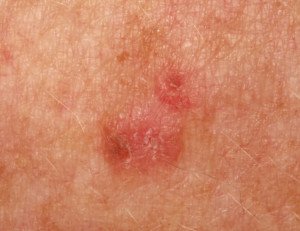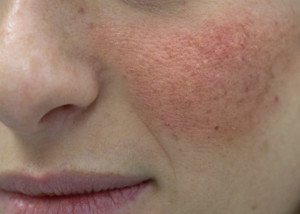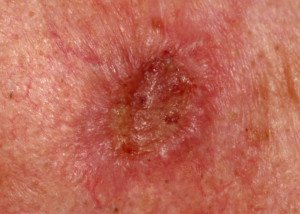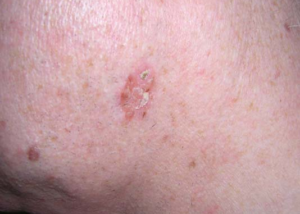Have you been religiously applying Efudex to your actinic keratosis lesions but after several weeks, nothing has happened?
Squamous cell carcinoma can be the result of actinic keratoses that are left untreated.
This skin cancer, though on the same continuum as actinic keratosis, will almost never respond to Efudex.
For squamous cell carcinoma, some form of surgery is usually the course of treatment.
It’s extremely important to eradicate actinic keratoses, because these patches of sun damage have the potential to transform into squamous cell carcinoma at a rate of about 10 percent if left untreated.
“Efudex cream is composed of 5-fluorouracil, or 5-FU, a chemotherapeutic agent,” says Adam J. Mamelak, MD, a board certified dermatologist and founder of Sanova Dermatology in Austin, TX.
Dr. Mamelak explains, “5-FU works by interfering with the growth of highly metabolic and quickly growing cells, like the precancerous actinic keratoses.”
The classic tell-tale sign of these atypical cell clusters is their sandpaper feel to the fingertips.
They also usually appear as patches or areas of skin that have some shade of pink or pinkish light brown.
It’s aggravating to be following the instructions for the Efudex (which vary by prescribing physician) and not to see any changes in the lesions.
You know the Efudex is working when the actinic keratoses begin deepening in color (as inflammation sets in), and then especially when scabs begin forming over them.
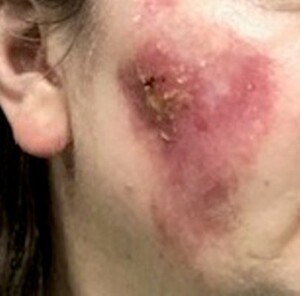
Efudex is beginning to work, as evidenced by the deepening color and the early formation of scabs.
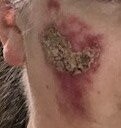
More scabbing: nature’s bandage to protect the new healthy skin growing beneath.
If this does NOT happen, though, despite weeks of Efudex application, this can be quite alarming.
Reasons Actinic Keratoses May Not Respond to Efudex
Dr. Mamelak explains, “While Efudex has been around for a number of decades, clearance rates can depend on a number of factors.
“This includes concentration (0.5%, 1%, 5%) of the 5-FU active ingredient in the preparation used; frequency (once-a-day, twice-a-day) and duration (one week vs. six weeks) of the applications; area of the body treated; thickness of the keratosis, and others.
“Medical studies have never shown 100% clearance with 5-FU. However, depending on the combination of variables above, clearance of over 80% of lesions has been reported.
“If an actinic keratosis does not respond, there could be a couple reasons.
“The treatment might not have been applied correctly.
“The patients had to stop early due to irritation and discomfort (a common side effect).
“The cream didn’t penetrate the thick lesion.”
There is also the possibility of perceived ineffectiveness, in that the patient gives up too soon, or loses track of just how long or often they’ve been applying the Efudex.
The patient may be just one more week’s worth of application away from this topical drug actually starting to work – even though they’ve completed the prescribing physician’s instructions for number of weeks applied.
It can easily be that the “apply daily for two weeks” protocol doesn’t work, but that waiting a week, and then applying again for one week, may then start showing a response.
Another factor to consider is that Efudex doesn’t necessarily show signs of working DURING the treatment.
The scabbing may not begin developing until a week or so after the last application.
But leading up to the scabbing, the patient should see the reddening due to the inflammation.
Can unresponsive actinic keratoses mean squamous cell carcinoma?
Dr. Mamelak explains, “However, if an actinic keratosis does not respond to multiple treatments. it should be evaluated.
“The actinic keratosis might have transformed into skin cancer, in which case a biopsy or another treatment might need to be considered.”
If your doctor tells you that squamous cell carcinoma is treated “the same as actinic keratosis,” don’t let this lower your guard.
Only a minority of cases of squamous cell carcinoma are treated topically.
Insist on a biopsy if your actinic keratosis – after considering all of the aforementioned variables – has not responded to thick applications of Efudex.
 Dr. Mamelak focuses on the full breadth of dermatologic care, from cosmetic skin solutions to advanced skin cancer removal. He’s founder of the Austin Mohs Surgery Center, which is dedicated to the treatment and management of skin cancer.
Dr. Mamelak focuses on the full breadth of dermatologic care, from cosmetic skin solutions to advanced skin cancer removal. He’s founder of the Austin Mohs Surgery Center, which is dedicated to the treatment and management of skin cancer.
 Lorra Garrick has been covering medical, fitness and cybersecurity topics for many years, having written thousands of articles for print magazines and websites, including as a ghostwriter. She’s also a former ACE-certified personal trainer.
Lorra Garrick has been covering medical, fitness and cybersecurity topics for many years, having written thousands of articles for print magazines and websites, including as a ghostwriter. She’s also a former ACE-certified personal trainer.
.

